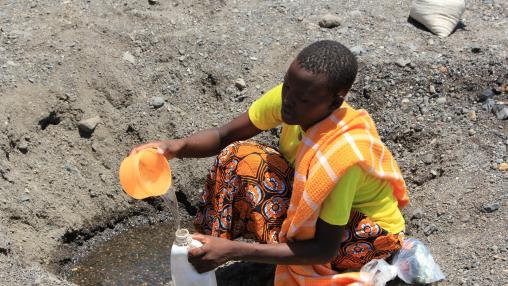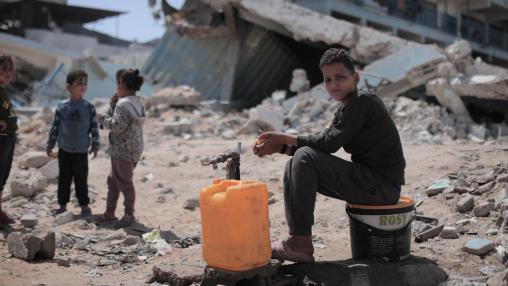Somalia: Acute Food Insecurity Situation for July - September 2025 and Projection for October - December 2025
In northern regions, poor rainfall and drought conditions led to failed crop production and poor livestock production and reproduction. In central and southern Somalia, conflict and flooding hampered crop production in agropastoral and riverine livelihoods leading to population displacement, disrupting livelihood activities and market access.
In the projection period (October to December 2025), the food security situation is expected to worsen as the Deyr season rainfall is likely to be below normal. Below-average rainfall, high food prices, continued conflict, and localised flooding are projected to drive 4.4 million people (23 percent of the population) into high levels of acute food insecurity (Phase 3 or above). During this period, the food security situation of urban IDPs in Bay and Bakool is expected to deteriorate from Phase 3to Phase 4. Among urban populations in Nugaal (Burtinle and Eyl), the food security situation is likely to deteriorate from IPC Phase 2 (Stressed) to Phase 3.

Food and Nutrition Crises Burgeon in Face of Conflict, Funding Cuts: GRFC Mid-Year Update Released
Hunger and food crisis have reached catastrophic levels in multiple places around the world, according to the Global Report on Food Crises Mid-Year Update. Famine has been confirmed in the Gaza Strip and the Sudan, with parts of South Sudan at risk of famine and Yemen, Haiti, and Mali experiencing catastrophic levels of hunger.
In all, 1.4 million people faced IPC Level 5 (Catastrophe) food insecurity and hunger as of August 2025.
Guatemala: Acute Food Insecurity Situation for May - August 2025 and Projections for September 2025 - January 2026 and February - April 2026
For the first projection period, September 2025 to January 2026, a relative improvement is expected, with around 2.6 million people (14 percent of the population analysed) in IPC Phase 3 or above. This includes 2.4 million in Phase 3 (Crisis) and 185,000 in Phase 4 (Emergency). This represents a 5 percent reduction compared with the previous period, attributed to improved food availability in some areas.
However, for the second projection period, February to April 2026, a deterioration is anticipated, with about 3 million people (16 percent of the population analysed) in IPC Phase 3 or above. Of this total, around 2.8 million would remain in Phase 3 (Crisis) and more than 248,000 in Phase 4 (Emergency), reflecting the persistence of structural factors that continue to undermine food security.
Mozambique: Acute Food Insecurity Situation for April - September 2025 and Projection for October 2025 - February 2026
The key drivers of the situation include climatic shocks—drought and irregular rainfall—in the southern and central areas of the country, as well as high food prices. In recent months, the northern part of the country has experienced a cessation of conflict and a degree of stabilisation, enabling the return of approximately 700,000 people. Despite this, more than 9,000 people remain internally displaced in Cabo Delgado. Displaced households and households in the process of returning to safe areas often face significant challenges, including limited access to agricultural production, livestock, and other forms of income generation. Their capacity to resume sustainable livelihoods remains severely constrained, leaving many entirely reliant on humanitarian food assistance. Meanwhile, sporadic attacks continue to occur in the districts of Macomia and Quissanga, where conflict continues to undermine security and recovery efforts.
Uganda: Acute Food Insecurity Situation June - July 2025 and Projection for August 2025 - February 2026
The improvement is largely due to the expected strong harvest season. However, food insecurity remains persistent in Karenga, Napak, Kaabong, Moroto, and Kotido, where between 30 and 45 percent of the population are still classified in IPC Phase 3 or above. It remains essential to implement activities aimed at reducing the food consumption deficits of food insecure populations as well as strengthening their resilience capacities.
Kenya: Acute Food Insecurity Situation for July - September 2025 and Projection for October 2025 - January 2026 (ASAL)
The current situation has improved compared to the period between February and March 2025 when 2.2 million people faced high levels of acute food insecurity. The improvement is attributed to above-average rainfall, which positively impacted crop and livestock production, and water availability and access, leading to slightly improved household food security in the arid and semi-arid lands (ASALs).
During the projection period (October 2025 to January 2026), the food security situation is expected to deteriorate, particularly during the short rains season (October–December 2025). An estimated 2.1 million people are expected to face high levels of acute food insecurity (IPC Phase 3 or above). The deterioration is mainly driven by forecasted below-average rainfall, which is expected to further affect staple food prices, alongside conflicts over resource management. Compared to the same period last year, the population projected in Phase 3 or above has increased from 11 to 13 percent with around 2 million people expected to be in Phase 3, and approximately 160,000 people in Phase 4.
Madagascar: Acute Food Insecurity Situation for May - September 2025 and Projections for October 2025 - January 2026 and January - April 2026
Conditions are expected to deteriorate during the first projection period (October 2025 to January 2026), with 1.5 million people projected to face Phase 3 or above, including a sharp increase of 84,000 people in Phase 4. This deterioration is primarily driven by an early lean season, resulting in poor harvests and elevated food prices, which undermine both availability and accessibility of food.
A further decline is anticipated in the second projection period (February to April 2026), with nearly 1.64 million people expected to face high levels of acute food insecurity, including 110,000 people in Phase 4 (Emergency). Alarmingly, marginalised and low-income rural households are disproportionately affected, with 5 to 10 percent of the population in some areas projected to be in Phase 4, even during the peak harvest season.
This worsening crisis is driven by a combination of recurring climate shocks (including droughts, floods, and cyclones), major agricultural disruptions (such as delayed planting and locust infestations), declining purchasing power, and limited access to essential services and humanitarian assistance. These factors are compounded by chronic poverty and fragile community resilience, placing millions at heightened risk.

Famine Confirmed in Gaza Strip
The chance to prevent widespread famine in the Gaza Strip has passed, according to the IPC Famine Review Committee (FRC). The prolonged food crisis in Gaza reached an unprecedented and devastating level in July and August, with the FRC confirming famine in Gaza Governate and projecting famine thresholds to be crossed in Deir al-Balah and Khan Younis Governates in the coming weeks. This latest update places more than half a million people at risk of starvation.
Gaza Strip: Acute Food Insecurity Situation for 1 July - 15 August 2025 and Projection for 16 August - 30 September 2025

Hunger declines globally in 2025 but remains above pre-pandemic levels: New State of Food Security and Nutrition in the World Report released
With the Sustainable Development Goal (SDG) deadline of 2030 fast approaching, the clock is ticking for the world to meet its goal of eradicating hunger and food insecurity. Some progress was made toward this milestone in 2024; however, hunger levels remain above their pre-pandemic levels, according to the 2025 State of Food Security and Nutrition in the World report.